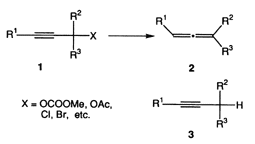
Electroreductive Cleavage of Propargylic Acetates throgh Polarity Inversion of in situ Generated Allenyl Palladium(II) Complexes and, in Part, Unusual Chemical Reduction Induced by Phosphine Ligand
Tanaka, H.; Takeuchi, H.; Ren, Q.; Torii, S. Electroanalysis 1996, 8, 769.
The electroreduction of propargyl acetates in the presence of a catalytic amount of PdCl2(PPh3)2/PPh3 in DMF containing Et4NOTs at ambient temperature under a constant current density (10mA/cm2) afforded the corresponding allenes in 43-84% yields. The time-course of the reaction was monitored by HPLC, indicating that the allenes were formed immediately after the current was supplied and that most of the starting materials were consumed when less than the theoretical amount of electricity (2 F/mol), typically 1.2-1.7 F/mol, was passed. Notably, a considerable amount of phosphine oxide was formed in the electroreduction media. Both the reductive cleavage of the propargylic acetates and the formation of phosphine oxide did not occur without passing electricity. The unusual results suggest that chemical reduction wiht the phosphine ligand would take place, in part, during the coarse of the electroreduction. A plausible reaction mechanism involving electroreductive polarity inversion of in situ generated allenyl Pd(II)-complex as well as chemical reduction with the triphenylphosphine ligand leading to allenyl anion species is proposed.
